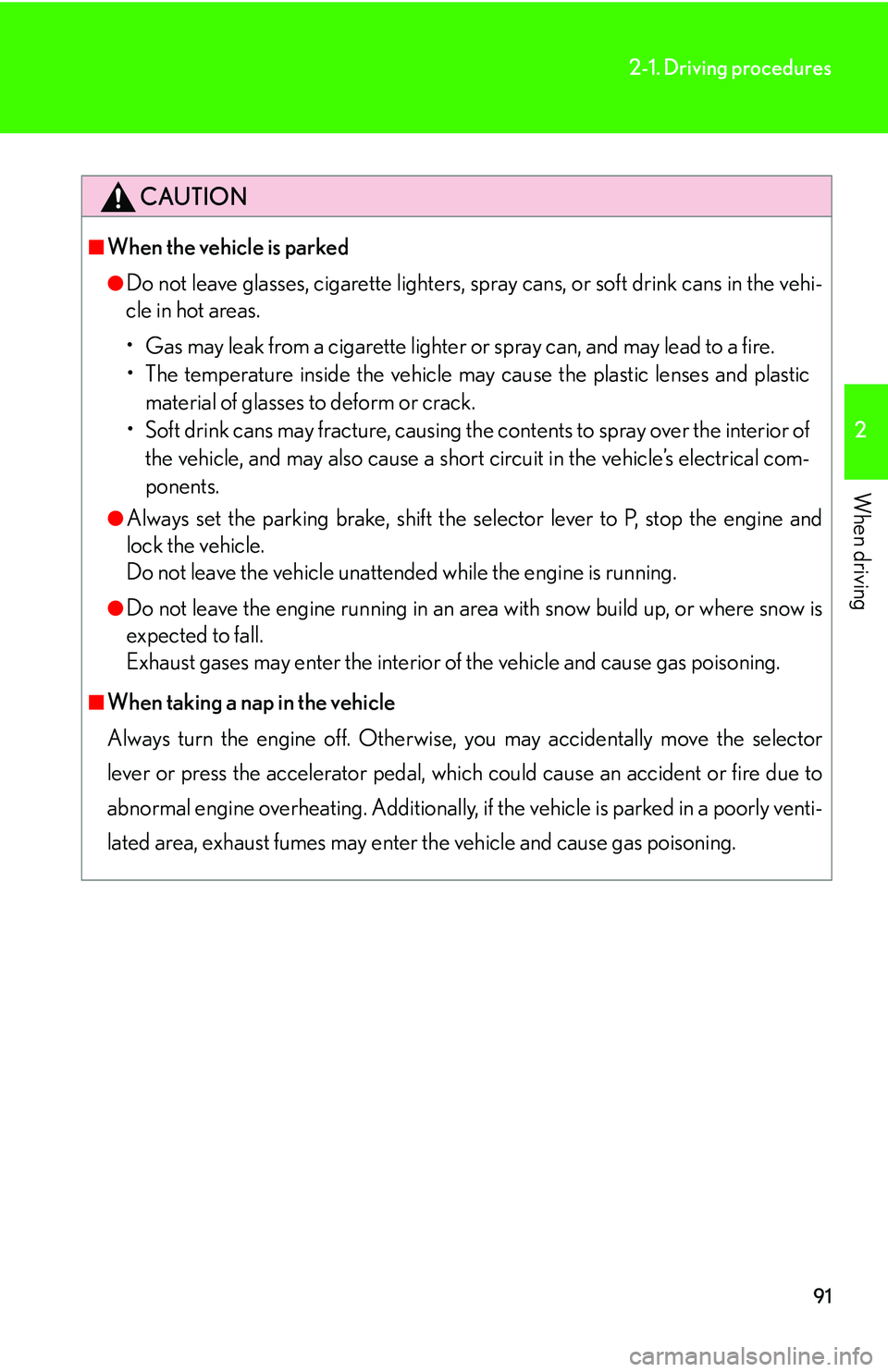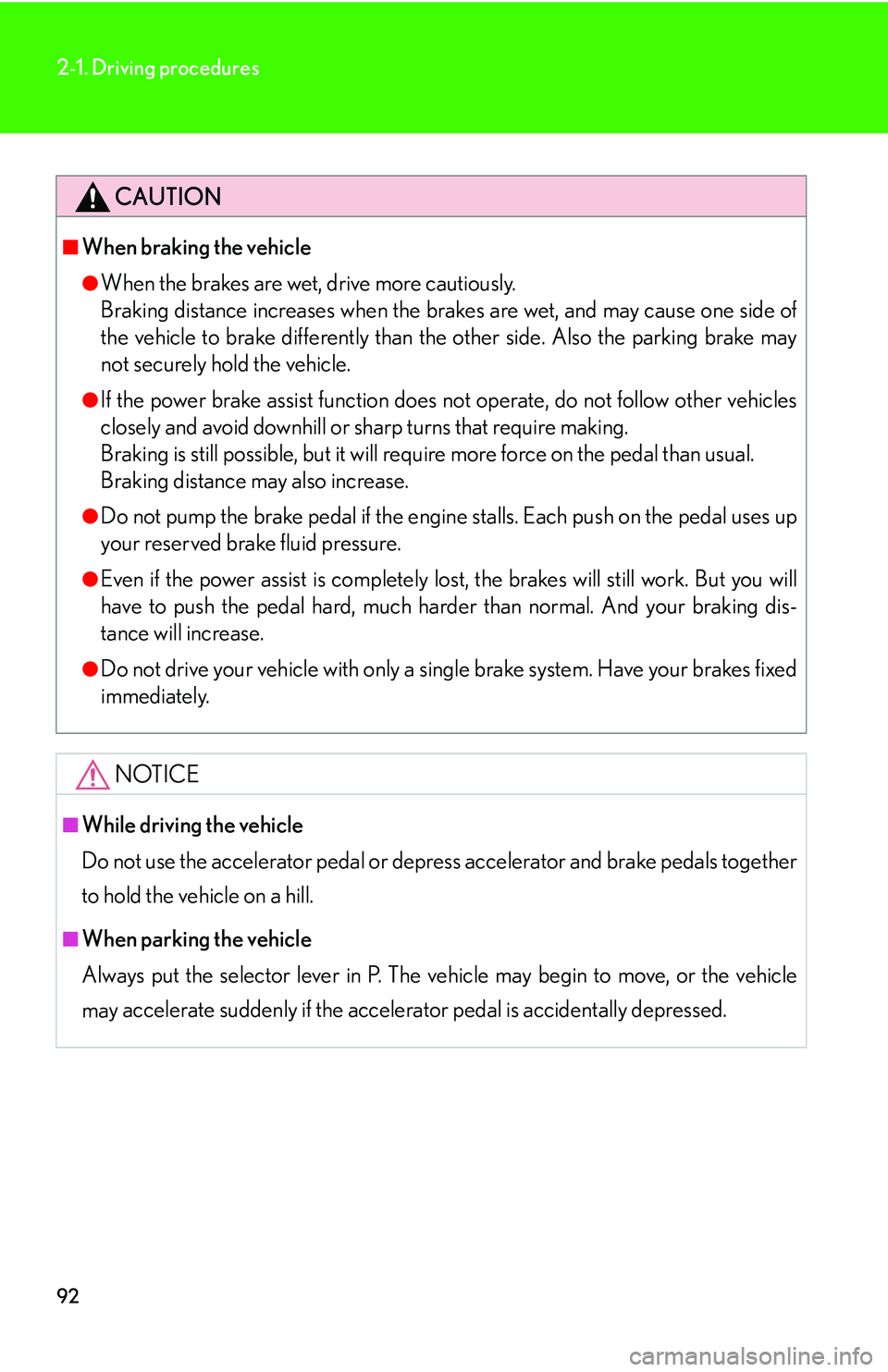Page 106 of 419

90
2-1. Driving procedures
CAUTION
■While driving the vehicle
●Be careful when driving on slippery surfaces, as the vehicle may skid or spin when
downshifting, rapidly accelerating, braking or turning.
●Do not adjust the position of the steering wheel, seat, or mirror while driving.
Doing so may result in losing control of th
e vehicle and cause an accident, which
may cause death or serious injury.
●Always check that passengers’ arms, heads or other parts of their bodies are not
outside the vehicle, as this may result in death or serious injury.
■When shifting the selector lever
Use caution if accelerating while shifting.
This may lead to unexpected rapid acceleration of the vehicle that may cause an
ac
cident.
■When the vehicle is stopped
●Do not race the engine.
If the vehicle is in any gear other than P or N the
vehicle may accelerate suddenly
and unexpectedly, and may cause an accident.
●Do not leave the vehicle with the engine running for a long time.
If such a situation cannot be avoided, park the vehicle in an open space and
che
ck that exhaust fumes do no t enter the vehicle interior.
●Always keep a foot on the brake pedal while the engine is running to prevent an
accident caused by the vehicle moving.
Page 107 of 419

91
2-1. Driving procedures
2
When driving
CAUTION
■When the vehicle is parked
●Do not leave glasses, cigarette lighters, spray cans, or soft drink cans in the vehi-
cle in hot areas.
• Gas may leak from a cigarette lighter or spr
ay can, and may lead to a fire.
• The temperature inside the vehicle may cause the plastic lenses and plastic
m
aterial of glasses to deform or crack.
• Soft drink cans may fracture, causing the co ntents
to spray over the interior of
the vehicle, and may also cause a short circuit in the vehicle’s electrical com -
ponents.
●Always set the parking brake, shift the se lector lever to P, stop the engine and
lock the vehicle.
Do not leave the vehicle unattend ed
while the engine is running.
●Do not leave the engine running in an area with snow build up, or where snow is
expected to fall.
Exhaust gases may enter the interior of the vehicle and cause gas poisoning.
■When taking a nap in the vehicle
Always turn the engine off. Otherwise, you may accidentally move the selector
le
ver or press the accelerator pedal, which could cause an accident or fire due to
abnormal engine overheating. Additionally, if the vehicle is parked in a poorly venti-
lated area, exhaust fumes may enter the vehicle and cause gas poisoning.
Page 108 of 419

92
2-1. Driving procedures
CAUTION
■When braking the vehicle
●When the brakes are wet, drive more cautiously.
Braking distance increases when the brakes are wet, and may cause one side of
th
e vehicle to brake differently than the other side. Also the parking brake may
not securely hold the vehicle.
●If the power brake assist function does not operate, do not follow other vehicles
closely and avoid downhill or sharp turns that require making.
Braking is still possible, but it will re quir
e more force on the pedal than usual.
Braking distance may also increase.
●Do not pump the brake pedal if the engine stalls. Each push on the pedal uses up
your reserved brake fluid pressure.
●Even if the power assist is completely lost, the brakes will still work. But you will
have to push the pedal hard, much hard er than normal. And your braking dis-
tance will increase.
●Do not drive your vehicle with only a single brake system. Have your brakes fixed
immediately.
NOTICE
■While driving the vehicle
Do not use the accelerator pedal or depres s acceler
ator and brake pedals together
to hold the vehicle on a hill.
■When parking the vehicle
Always put the selector lever in P. The vehicle may begin to move, or the vehicle
ma
y accelerate suddenly if the accelerat or pedal is accidentally depressed.
Page 109 of 419
93
2-1. Driving procedures
2
When driving
NOTICE
■Avoiding damage to vehicle parts
●Do not turn the steering wheel fully in either direction and hold it there for a long
time. Doing so may damage the power steering pump.
●When driving over bumps in the road, drive as slowly as possible to avoid damag-
ing the wheels, underside of the vehicle, etc.
■If you hear a squealing or scraping no ise (brake pad wear limit indicators)
Have your Lexus dealer check and replace the brake pads as soon as possible.
Exp
ensive rotor damage can result if the pads are not replaced when needed.
■If a malfunction is detected while driving
A flat or damaged tire may c
ause the following situations. Hold the steering wheel
firmly and gradually press the brak e pedal to slow down the vehicle.
• It may be difficult to control your vehicle.
• The vehicle will make abnormal sounds.
• The vehicle will behave abnormally.
Replace a flat tire with a new one. ( P.
3 4 7 )
Page 110 of 419
94
2-1. Driving procedures
Starting the engine
■Ignition switch
LOCK:
Inserting and removing the key
ACC:
The audio system and other
acces
sories can be used when
the engine is stopped.
ON:
When driving the vehicle the
engine an
d all accessories are
on.
START:
For starting the engine.
■ Star
ting the engine
Check that the parking brake is set.
Check that the selector lever is set in P.
If you need to restart the engine while the vehicle is moving, put the
selector lever in N.
Sit in the driver’s seat and firmly depress the brake pedal.
Push and turn (if the smart access s
ystem is engaged) or turn the
ignition switch to STAR T and star
t the engine.
1
2
3
4
Page 114 of 419
98
2-1. Driving procedures
Automatic transmission
Select a gear position appropriate for the driving conditions.
■Shifting the transmission selector lever
While the engine is running, the brake pedal must be depressed in order to
move the transmission selector lever from P.
■Gear uses
* Always use the “D” position to improve fuel economy and quiet driving.
Shift range
PParking the vehicle and starting the engine
(key removal position)
RReversing
NNeutral
DNormal driving*
S“S” mode driving
6Normal driving
5Accelerating/passing at high speed driving
4Driving on hilly roads or heavy towing
3Driving downhill when strong engine braking is necessary
2Driving downhill when stronger engine braking is necessary
1Driving downhill when maximum engine braking is
necessary
Page 118 of 419
102
2-1. Driving procedures
Parking brake
NOTICE
■Before driving
Fully release the parking brake.
Driving the vehicle with the parking brake set will lead to brake components over -
heating, which may affect braking performance and increase brake wear.
Sets the parking brake
Depress the brake pedal with the
right foot and fully depress the
parking brake pedal with the left
foot.
Releases the parking brake
Pull the lever to release the park -
ing brake.
1
2
Page 127 of 419

111
2-3. Operating the headlight and windshield wipers
2
When driving
Daytime running light system
The headlights turn on automatically (at a reduced intensity) whenever the
engine is started and the parking brake is released to make your vehicle
more visible to other drivers. Dayt ime running lights are not designed for
use at night.
■Headlight control sensor
■Automatic light off system
The headlights turn off automatically if the engine is stopped and the driver’s door is
opened wh
ile the headlights are turned on.
To turn the headlights on again, turn the key to ON, or turn the light switch off once
and then
back to or position.
■Automatic headlight leveling system
The level of the headlights is
automatically adjusted according to the number of
passengers and the loading condition of the vehicle to ensure that the headlights do
not interfere other road users.
■Customization
The time it takes for the headlights to automatically turn on or off can be changed.
( P.384 )
The sensor may not function properly if an
object is placed on the sensor, or anything
that blocks the sensor is affixed to the wind-
shield.
Doing so interferes with the sensor detect-
ing the level of ambient light and may cause
the automatic headlight system malfunc-
tion.